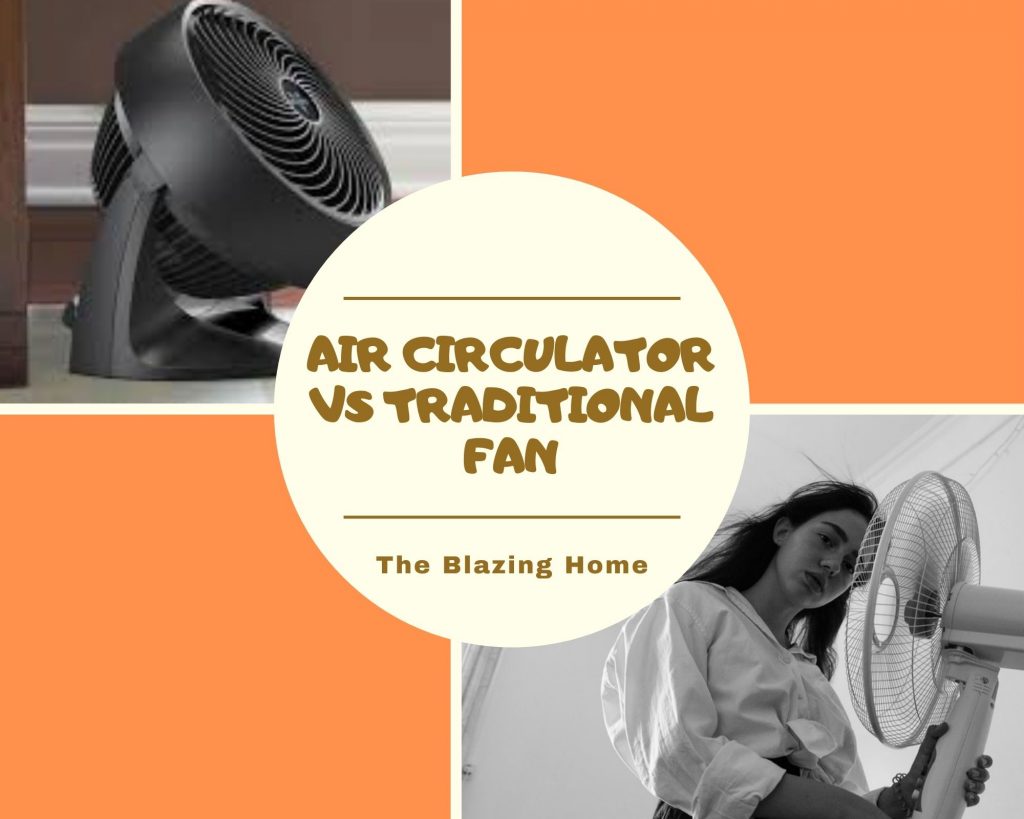One of our readers asked a very important question a few days ago “Are air circulator fans better than regular fans?”. He is in a puzzle between these two types of fans. Since it is not possible to answer him in a nutshell, we are decided to write a narrative article on this important topic. Hopefully, it will be helpful for him and you also!
Well, an air circulator fan seems very fancy and sophisticated machine than a traditional fan. But, in reality, they are affordable and easy to use. Air circulator fans defeat a regular fan in terms of energy efficiency, performance, portability, and flexibility. Our expert will explain everything on this topic in depth. By ending this article, you will get enough information about these two types of fans so that you can decide which fan will be the perfect match and best for you.
Air Circulators vs. Traditional Fans: The Choice For You!
The Main Difference Between This Two
In general, a traditional cooling fan will only give you cooling benefits if and only if the airflow direction of the fan is pointing towards you. Only a few regular fan models can provide aerodynamics benefits. Most of the traditional fans aren’t capable to move the air in the entire room. Hence, everyone in the room will not get an equal cooling facility for the fan.
An air circulator is such a special type of fan that can easily maintain constant airflow in the whole room. Not just blow air in a particular portion of the room like ceiling or pedestal fan. You need to reposition regular fan airflow direction if you move from one corner of the room to completely opposite corner of the room. This is very painful to move the fan like this because they are not as portable and lightweight as air circulator fans. If you have an air circulator instead of a pedestal fan, you don’t have to move the fan like this as they cover the whole room with even airflow.
Usually, air circulator creates a 360° oscillating draught, mainly helping this fan to maintain a constant temperature in the room by eliminating cold and hot spots of the room. Most of the air circulator fan includes aerodynamic elements like blade duct, inlet air accelerator, deep-pitch propeller, and AirTensity™ grill. The combination of these aerodynamic elements result from a beam of spinning air that can travel long distance. The spinning beam of air blown from the air circulator reaches the opposite wall and hits it. Consequently, the direction of the air beam will change and return back to the air circulator again. Thus, it maintains the air circulation in the room. The entire procedure is demonstrated in the video.
This airflow also excites air and creates a continuous motion in the air. This excitation of room air assist in delivering comfort in the whole room and everyone will get equal cooling even though if you are in the last corner of the room.
Traditional fans blow air in such a way that it doesn’t let fresh air from the window enter inside the room easily. Hence, your room will become very stuffy although the outside environment isn’t stuffy at all, and also you have opened the window to let the cool air come inside. On the other hand, the stale air of an air circulator makes it so easy to let the fresh air of the open window come inside and circulate it all around. And thus, it removes the stuffiness of the room.
Where to Use
Household Use: Both traditional and air circulator fans are made to use in your house especially for your bedroom and living room. But traditional fans like bathroom fans can be used in your bathroom to remove stuffiness but air circulator fan can’t be used in a bathroom because they aren’t suitable for small areas.
Industries and workplaces: Air circulators are more productive to use in industries and workplaces rather than traditional fans. Because air circulators can cover a large area and also ensure constant airflow at every point of the room.
Outdoor use: Air circulator fans aren’t created for outdoor use. It can’t circulate air in an open place. They are specifically made for enclosed space. Traditional fans can be used in outdoor places like the patio and backyard.
Kitchen: although both traditional and air circulator fans are not manufactured for kitchen use. But you can use a table or tower fan for making your body cool only if you are using an exhaust fan. Otherwise, your fan will blow hot air. We also see some families use ceiling fans for cooling in the kitchen.
Oscillation
Oscillation is one of the most important features of a fan. A fan without an oscillation feature isn’t able to cover a huge area and consequently, only a few people will get the cooling benefits offered by a fan.
Well, the air circulator fan oscillates 360° which increases the air flowing efficiency of this fan to a great extent.
In the case of a traditional fan, we see a lot of diversity in oscillation angle. We see a fan with on oscillation, 90° oscillation, 180° oscillation, and 360° oscillation depending on the type of fan. The ceiling fan can rotate 360° although it can’t circulate air in the entire room like an air circulator fan. Among the other type of traditional fans, pedestals and tower fans can oscillate at 90°-180° depending on the fan model. Exhaust fans and box fans are the classical example of a fan without any oscillation feature.
Power Consumption
The power consumption of the fan is mainly depending on the radius of the blades of the fan. Other than that power consumption also depends on the air delivery rate and RPM rating of the motor.
We have found in our research that ceiling fan (the most common type of traditional fan) has a power rating of anywhere between 60-100W. The power rating of the pedestal and tower fan is between 50-60 W. But why this type of fan consumes nearly the same amount of power though it has a smaller sweep (radius) compared to a ceiling fan! The reason is that pedestal and tower fan offer greater RPM compare to a ceiling fan. Table fans also consume the same amount of power as pedestal fans since there is no difference between them except vertical rods.
Air circulator is energy efficient compare to traditional fan. It consumes less electricity. On average, an air circulator fan consumes 30-50 W of power.
Air Circulator’s Benefits Compared to The Traditional Fan
The main benefit of an air circulator fan compare to a traditional fan is that it can be used anywhere in the room. They are lightweight so you can move them easily. Traditional fans are also movable but placing it after moving aren’t easy because traditional fans are bulky compared to air circulator fan.
Furthermore, you can use an air circulator fan all season. Traditional fans are meant to use only for summer but air circulator fans are engineered in such a way that you can use them in both summer and winter.

Now you can ask me how can you use an air circulator fan in winter!!
Well, during the winter, we often use the heater to warm our house. But, as a nature of heat, warm air produced by the heater rises upward direction and stays at the ceiling of the room. So, you will not get the complete warm of the heater since the hot air is trapped on the ceiling. An air circulator fan will be pretty handy in this kind of scenario. By pointing the air circulator upward in the exact middle of the ceiling of the room and setting the seed low, will help to circulate the hot air travel equally all over replacing cool air on the floor. Consequently, you will get an even warm room temperature in the entire room. Also, it helps to reduce the load of the heater since the efficiency of the heater increase to a great extent.

On top of that best air circulator fan can increase the cooling efficiency of your air conditioner. Never heard about this kind of thing before, isn’t it? Don’t worry, we will explain it to you. Place your air circulator fan on the same wall where your air conditioner is. But, make sure it is on opposite direct same as the picture. Now, by pointing airflow of the fan 45° with the floor toward the opposite direction. This will assist your air conditioner to circulate cool airflow even better than before. Research shows that using both an air conditioner and air circulator at a time will decrease the room temperature by 5°F.
Conclusion
In the end, we can say that both these fans have separate advantages and disadvantages. Among these two fans, an air circulator fan will undoubtedly be the best choice for indoor use if you have a bigger room and you have a supportive air cooling system like an air conditioner in the room. But, you can also use it alone if you are in a moderately cold temper area like Australia. It will a great energy saver and cut your utility bill to a great extent. Another exceptional benefit of having an air circulator fan is that it can be used in winter as a heat distributing fan for your heater or stove. But you have to know the proper placement for getting the full advantage from this fan.
Regular fans are also a good choice especially for outdoor use in which air circulator is totally useless because they can’t air circulator air outdoor. So, have a pedestal or tower fan for the backyard or patio this summer if you don’t have any cooling system for those places.
Reference:

